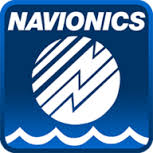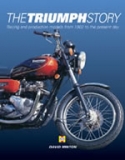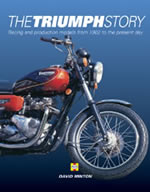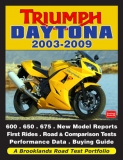Úvod »Letectví, kosmonautika»Dopravní letadla » Triumph Daytona 1991-2006
Anotace
| Vazba: | Brožovaná | ||
| Počet stran: | 156 | ||
| Rozměry v mm: | 210 x 280 | ||
| Počet obrázků: | 350 | ||
| Rok vydání: | 2012 | ||
When Triumph were reborn in a stunning manner in 1991, most observers expected that the top-of-the-range sports machine would be labelled as a Bonneville. But no. When the model line-up was announced, top sports honours were awarded to motorcycles carrying the word ‘Daytona’ in their title. Those canny Triumph folk had other plans for their Bonnevilles. Early Daytonas suffered a little from Triumph’s 'modular' approach to their new range. Almost all major components of both engines and cycle parts were as common across the entire range as was practical, given the need to appeal to as many riders as possible. A predictable result of this was that most of the early bikes were compromised … but where compromise can be seen as a negative, the character which also resulted from the design philosophy was the opposite. While all of the machines in those early days were competent, the Daytona stood out as being one of those which repaid effort and understanding on the part of the rider; the 4-cylinder Daytona 1000 in particular. Press testers were often critical, but owners loved them, even their very revvy, highly-strung character had its fans.
Daytona notoriety appeared in the form of the Daytona 1200, a machine of truly awesome performance; performance from the vastly powerful engine which the rest of the machine struggled to handle. Which is, of course, the stuff from which legends are made, and indeed those 1200cc, 145bhp monsters have a considerable fan following of their own, remaining blisteringly fast to this day. The 900cc 3-cylinder models were less rapid, but were also much more manageable. The arrival of the T595 Daytonas in 1997 changed everything. Suddenly, the modular approach was reduced in its impact, and Triumph built the first of their truly market sector-leading sports bikes using entirely new engine and cycle parts. To great effect; the new machines looked stunning, particularly in the brilliant gold finish, they sounded unique with their 3-cylinder engines howling on song, and their handling and braking were well up to the standards of the class. The model was renamed the 955i (which more accurately reflected the engine’s actual capacity) in 1999, and development was steady until its demise in 2006, by which time it was viewed more as a sports tourer by most pundits, rather than an out-and-out sports machine. The Daytona line changed again at this point, with the introduction of Triumph’s new 675 model, but that is another story… A total of 156 fully illustrated pages. SB.





























